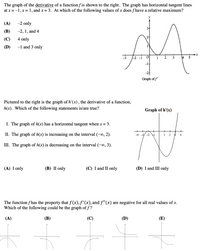
Calculus: Early Transcendentals
8th Edition
ISBN: 9781285741550
Author: James Stewart
Publisher: Cengage Learning
expand_more
expand_more
format_list_bulleted
Concept explainers
Question

Transcribed Image Text:The graph of the derivative of a function f is shown to the right. The graph has horizontal tangent lines
at x = -1, x= 1, and x = 3. At which of the following values of x does f have a relative maximum?
(A)
-2 only
3+
(В)
-2, 1, and 4
2+
(C)
4 only
(D)
-1 and 3 only
-1
Graph of f'
Pictured to the right is the graph of h' (x) , the derivative of a function,
h(x). Which of the following statements is/are true?
Graph of h'(x)
I. The graph of h(x) has a horizontal tangent when x = 3.
II. The graph of h(x) is increasing on the interval (-∞, 2).
- -2 1
1
2
4
III. The graph of h(x) is decreasing on the interval (-∞0, 3).
(A) I only
(В) П only
(C) I and II only
(D) I and III only
The function f has the property that f(x),f'(x), and f"(x) are negative for all real values of x.
Which of the following could be the graph of f?
(A)
(В)
(C)
(D)
(E)
Expert Solution
This question has been solved!
Explore an expertly crafted, step-by-step solution for a thorough understanding of key concepts.
This is a popular solution
Trending nowThis is a popular solution!
Step by stepSolved in 3 steps with 2 images

Knowledge Booster
Learn more about
Need a deep-dive on the concept behind this application? Look no further. Learn more about this topic, calculus and related others by exploring similar questions and additional content below.Similar questions
- The graph y = f(x) is given, Sketch the graph of y = f'(x) on top of the graph and sketch y = f"(x) on the second graph .Clearjy label the coordinates of the x-intercepts of each graph.arrow_forwardA function f(x) and it’s first and second derivatives are given below. Use that information and the graphing strategy to graph each function.arrow_forwardYou are told that g is a one-to-one function with values g(8) = -2 and g(3) = -9. Which of the following must be true? Select all correct answers. Select all that apply: O g-'(-9) = 8 O g-'(3) = 9 O g'(-2) = –9 O g'(-2) = 8 O g(-9) = 3 %3Darrow_forward
Recommended textbooks for you
 Calculus: Early TranscendentalsCalculusISBN:9781285741550Author:James StewartPublisher:Cengage Learning
Calculus: Early TranscendentalsCalculusISBN:9781285741550Author:James StewartPublisher:Cengage Learning Thomas' Calculus (14th Edition)CalculusISBN:9780134438986Author:Joel R. Hass, Christopher E. Heil, Maurice D. WeirPublisher:PEARSON
Thomas' Calculus (14th Edition)CalculusISBN:9780134438986Author:Joel R. Hass, Christopher E. Heil, Maurice D. WeirPublisher:PEARSON Calculus: Early Transcendentals (3rd Edition)CalculusISBN:9780134763644Author:William L. Briggs, Lyle Cochran, Bernard Gillett, Eric SchulzPublisher:PEARSON
Calculus: Early Transcendentals (3rd Edition)CalculusISBN:9780134763644Author:William L. Briggs, Lyle Cochran, Bernard Gillett, Eric SchulzPublisher:PEARSON Calculus: Early TranscendentalsCalculusISBN:9781319050740Author:Jon Rogawski, Colin Adams, Robert FranzosaPublisher:W. H. Freeman
Calculus: Early TranscendentalsCalculusISBN:9781319050740Author:Jon Rogawski, Colin Adams, Robert FranzosaPublisher:W. H. Freeman
 Calculus: Early Transcendental FunctionsCalculusISBN:9781337552516Author:Ron Larson, Bruce H. EdwardsPublisher:Cengage Learning
Calculus: Early Transcendental FunctionsCalculusISBN:9781337552516Author:Ron Larson, Bruce H. EdwardsPublisher:Cengage Learning

Calculus: Early Transcendentals
Calculus
ISBN:9781285741550
Author:James Stewart
Publisher:Cengage Learning

Thomas' Calculus (14th Edition)
Calculus
ISBN:9780134438986
Author:Joel R. Hass, Christopher E. Heil, Maurice D. Weir
Publisher:PEARSON

Calculus: Early Transcendentals (3rd Edition)
Calculus
ISBN:9780134763644
Author:William L. Briggs, Lyle Cochran, Bernard Gillett, Eric Schulz
Publisher:PEARSON

Calculus: Early Transcendentals
Calculus
ISBN:9781319050740
Author:Jon Rogawski, Colin Adams, Robert Franzosa
Publisher:W. H. Freeman


Calculus: Early Transcendental Functions
Calculus
ISBN:9781337552516
Author:Ron Larson, Bruce H. Edwards
Publisher:Cengage Learning